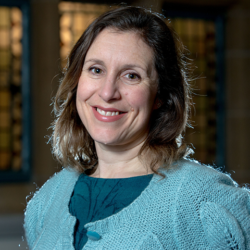Small changes can make a big difference to inclusion

With National Inclusion Week, Jenny Brady, Project lead for Inclusive Learning and Teaching the University of Leeds, examines what inclusion and accessibility means for online content, what's on, and how we can all make a difference.
National Inclusion Week provides us with an opportunity to reflect on and celebrate everything that we do, and can do, in making our students feel valued and welcomed as individuals in our institution.
The theme of this year’s event is Each One, Reach One, which is a reminder to all of us that small things we do as individuals have a big impact on the experiences of those around us.
So, what are some of these small actions we can all take when working in an online environment?
In this blog, I look at inclusion and accessibility of online content, how to foster a sense of belonging and provide links to resources and ways to get involved.
Valued
Small changes we can make for one group of students can be of benefit to all students.
When we make things clearer, more consistent and allow for some flexibility in how, when and what format students can access learning opportunities, we are allowing them to feel that they’re a valued member of our group.
We need to move away from outdated deficit models of additional support and labelling students as non-traditional, as it only serves to compound the idea that university education is only designed for one particular type of learner.
With an increased need for online delivery, digital accessibility is a good starting place for inclusive teaching and creating resources that are born accessible from the outset should be the ultimate aim.
Support
Recently introduced legislation around accessibility of online content provides us with another push towards consistency and fairness for our students.
Providing documents in Word, rather than pdf format, for example, will mean they’re more accessible to people using screen reading software, but also are more user-friendly for viewing on a phone.

AUTHOR: Jenny Brady, project-lead for Inclusive Learning and Teaching.
This is my own pet hate as the text on a pdf doesn’t adjust to screen size, making it easy to lose my place in documents.
We’ve become so used to producing documents and resources in our own way, but never had to consider that there might be a right way and a wrong way.
It's worth putting in some time to learn the basics of digital accessibility, and the Organisational Development and Professional Learning's (OD&PL) Digital Accessibility website aims to help with that.
The Accessibility and Inclusion page of the Digital Practice website also provides a range of FAQs to help you remediate existing teaching resources.
As part of National Inclusion Week, Laura York, Equality Policy Unit, and Kirsten Thompson, of OD&PL, are putting on an Accessible Document Training Session on Monday September 28, 12 to 1pm that can be booked through the Equality Policy Unit website.
A recently introduced tool in Minerva, Blackboard Ally, provides further support for making teaching materials more accessible for all students, enabling additional flexibility and in some cases negating the need for specialist software or support.
Following the step-by-step instructions Ally provides, materials can be improved, for example, by using inbuilt headings and labels on images.
Students can then access resources in a variety of formats, such as audio versions of long documents, or e-reader friendly versions.
That’s great news for students who find reading challenging, but also students who might want to listen to something on the go, or read on their Kindle.
Flexibility of access is also greatly improved by adding captions to video content; making a world of difference to hearing impaired people but also supporting comprehension for students who don’t have English as a first language.
And in my experience, it’s just good to have the option of having the sound off sometimes.
Further resource
Earlier this month, I joined Alice Shepherd, from LUBS and Kirsten Thompson, in their recent LITE Share Adapt Adopt Workshop on How to Make your Teaching Accessible and Inclusive, which can be viewed on the LITE Stream Channel, only available to staff at Leeds.
Nina Wardleworth, the Student Success Academic Lead based in LITE, has been developing and curating resources to support Inclusive Curriculum Design which can be accessed in the Minerva Inclusive Curriculum Design Organisation - requires staff access - covering a wide range of topics.
These range from diversifying the curriculum to enable students to see their identities reflected in what they're learning, to embedding academic skill development as part of the curriculum.
The resource includes a checklist which can help you to think through the various aspect of this.
Belonging
We all need to feel that we belong, to be able to thrive and succeed in whatever we do.
This summer, colleagues from LITE have been working hard with the cross institutional working group on the Sense of Belonging workstream.
This work is intended to help colleagues consciously focus on something that they might have previously done intuitively in a face-to-face setting.
Remote learning now requires additional care to ensure students don't feel isolated.
There are a whole range of small actions we can take to forge this connection with students, for example, by using names as much as possible, and checking on the correct pronunciation if you’re not sure.
Acknowledge challenges students may face because of personal characteristics or circumstances, and connect to them by letting them know who you are as a person.
You can hear from Katie Livesey, LITE’s Teaching Excellence Manager, and others, about this work in their recent Share Adapt Adopt Workshop: Building a Student Community Online, on the LITE Stream Channel but only available to internal staff.
As part of this session, we hear from Susan Preston, a commuter student, about how the switch to studying online reduced her sense of inequality, leading her to feel that the learning was designed with people like her in mind, so increasing her sense of belonging .
A set of resources for staff have been developed to support the Sense of Belonging initiative, aimed primarily at personal tutors and those involved in induction activities, but useful to anyone involved in student education.
These are available as part of the wider work around Welcome, Induction and Transition which LITE fellows Ruth Payne and Andrew Mearman fed into as part of their ELIXIR project.
Two of the sessions in the Equality Policy Unit schedule of events for National Inclusion Week provide an opportunity to consider what Sense of Belonging means to you and how you can foster it.
And there's more. The Belonging at Leeds panel discussion, hosted by the Faculty of Engineering and Physical Sciences on Tuesday September 29, between 1 and 3pm, and a webinar on Bringing Your Authentic Self to the University of Leeds on Thursday, October 1, 2 to 3.15pm, co-hosted by LITE Fellow Brigette Bewick as part of her Pedagogical Wellbeing project.
Small changes
Think of the difference it would make to our students' sense of belonging if we planned for diversity as part of the curriculum and avoided assumptions about their knowledge of university culture and conventions from the start.
Simple actions, such as providing glossaries of new terms or links to specific academic skills resources can make students feel less like a square peg in a round hole.
Inclusive teaching is about taking a particular mindset; valuing and harnessing the diversity of our students, which should lead to a far richer, engaging experience for students and staff alike.
There are small simple actions we can all take to help our students know they belong and to reduce their need to seek out additional support.
We can start by anticipating diversity, improving the flexibility of access to digital materials online, and endeavoring to reach out and make a genuine connection with each one of our students.
